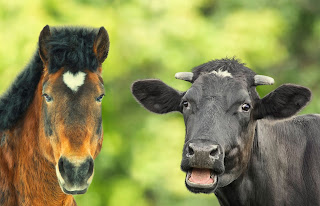A French study has confirmed that mixed grazing with cattle helps
control strongyle worms in horses.
Grazing horses with cattle is often suggested as a useful pasture
management tool to help control strongyle parasites. However, there has been
little research to assess the benefit.
With a few exceptions of minor significance, gastro-intestinal
parasites of horses and cattle are host specific. Thus, infective stages of
horse worms ingested by cattle will not develop to adults (and vice versa).
Not only do horses and cattle play host to different species
of gastro-intestinal parasites, they also have different grazing habits. Horses
tend to graze close to the ground and avoid areas that have been previously
contaminated with faeces – producing “lawns” and “roughs.” Cattle, on the other
hand, cannot graze so closely to the ground, but will graze areas avoided by
horses.
The study, by Forteau, Dumont and colleagues looked at the
management and worm control on horse breeding farms in two regions of France -
some of which employed mixed grazing of horses with cattle.
Forty-four farms were enrolled in the study. These included
saddlehorse production farms in Normandy (generally specialised sport horse
enterprises, on productive grassland) and northern Massif Central (leisure
horses- reared on less productive grassland). Some were specialised horse units;
others were mixed cattle and horse farms.
Using surveys and face to face interviews, the researchers recorded
details such as stocking rate; proportion of pasture used for grazing only or
for cutting and grazing; and the extent of integration of anthelmintic control
and pasture management.
Among the findings were:
- many farms were still relying on fenbendazole despite the well-recognised problems of anthelmintic resistance.
- mixed grazingof horses with cattle was uncommon. Only 8 out of 23 mixed horse and cattle breeders knew that grazing them on the same pasture could be used as part of their strongyle control strategy.
- in young horses last treated with moxidectin, those grazed with cattle had 50% fewer strongyle eggs excreted in their faeces than those grazed in equine-only pastures.
They conclude that mixed grazing of horses with cattle “opens
a promising alternative for controlling horse parasitic infection that remains
largely unknown by horse breeders.”
For more details, see:
Horses
grazing with cattle have reduced strongyle egg count due to the dilution effect
and increased reliance on macrocyclic lactones in mixed farms.
Forteau L,
Dumont B, Sallé G, Bigot G, Fleurance G.
Animal. 2019
Nov 4:1-7.



